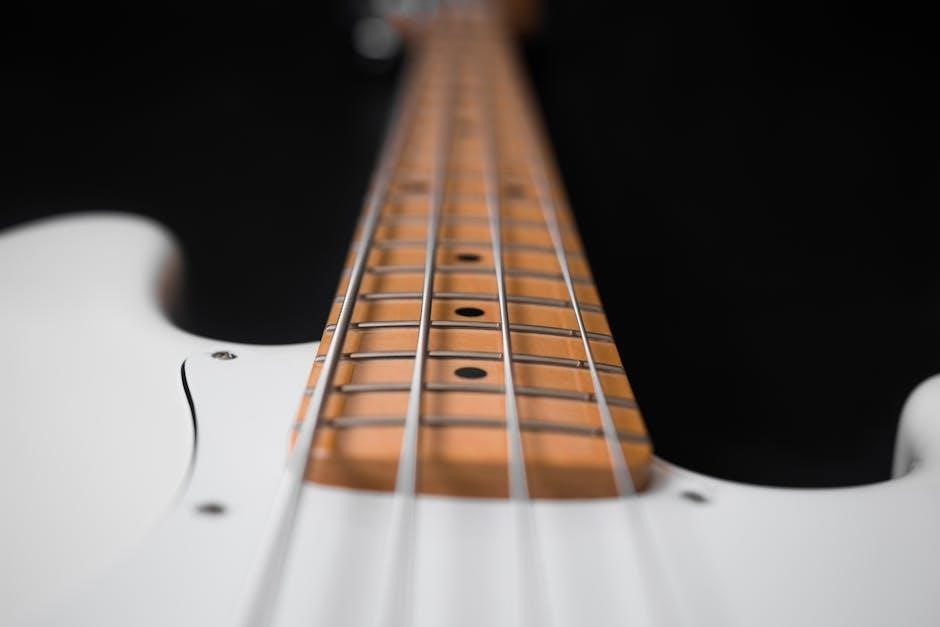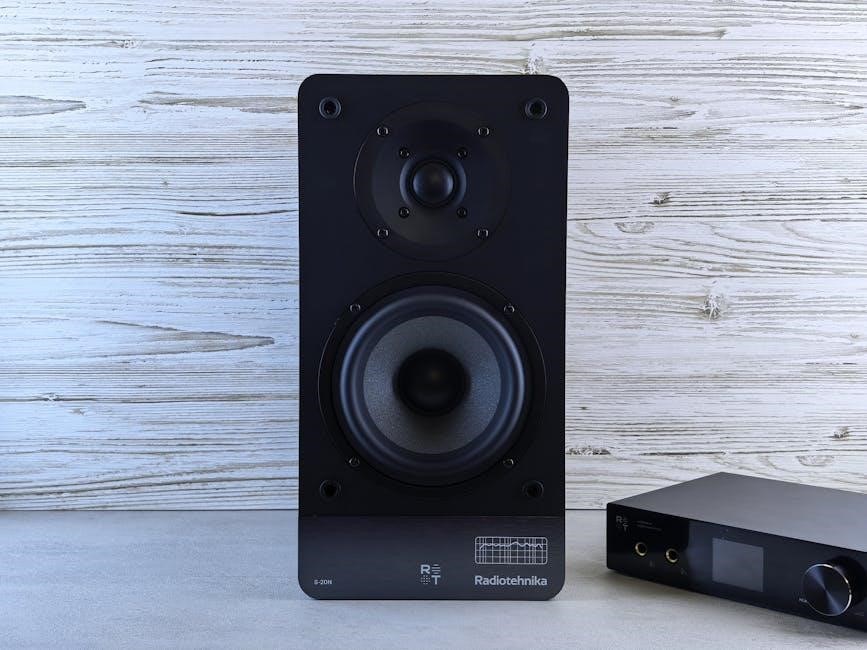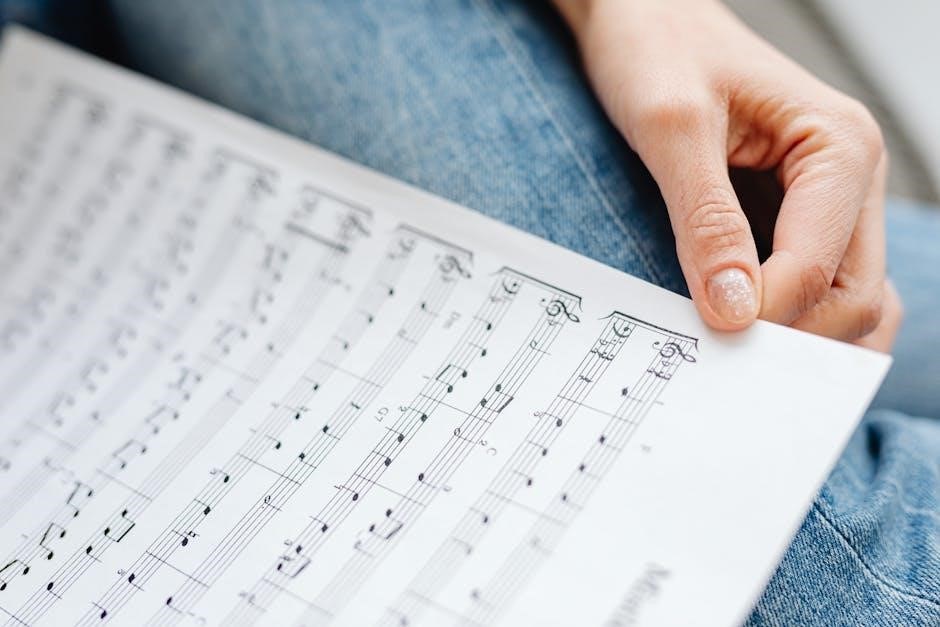Bass clef notes are crucial for musicians, particularly cellists and bassists. The staff comprises five lines and four spaces, each assigned specific letters. PDF resources aid practice and learning effectively.
1.1 Understanding the Bass Clef
The bass clef, also known as the F clef, is a musical symbol used to identify the pitch of notes on a staff. It is commonly used by instruments like cellos, trombones, and bassoons. The bass clef indicates that the fourth line of the staff represents the note F. Understanding the bass clef is essential for reading sheet music accurately, as it helps musicians identify the correct pitches. The staff consists of five lines and four spaces, with each line and space assigned specific note names. PDF resources, such as downloadable worksheets, are widely available to help musicians practice and master bass clef notation effectively.
1.2 Importance of Bass Clef in Music
The bass clef plays a vital role in music, providing lower-pitched instruments with a clear framework for reading notes. It ensures accurate pitch recognition, enabling seamless performance across various genres. PDF resources, such as downloadable worksheets and exercises, simplify learning, making the bass clef accessible to musicians of all levels. By mastering the bass clef, musicians enhance their ability to interpret complex compositions, fostering better musical understanding and collaboration. Its significance extends beyond notation, forming the backbone of harmonic structure in ensembles and orchestras.

Reading Bass Clef Notes
Reading bass clef notes involves understanding the staff’s five lines and four spaces, each assigned specific letter names. PDF resources provide clear, printable exercises for practice.
2.1 The Staff and Its Components

The staff in bass clef consists of five lines and four spaces, each assigned specific letter names. These components are fundamental for reading music notation accurately. PDF resources offer detailed exercises to practice labeling notes on the staff, enhancing recognition and understanding of pitch and rhythm. These exercises are designed to help musicians master the basics of bass clef notation, ensuring a solid foundation for further musical development. Regular practice with these tools improves sight-reading skills and overall musical literacy.
2.2 Lines and Spaces of the Bass Clef
The bass clef staff consists of five lines and four spaces, each assigned specific note names. The lines, from bottom to top, are labeled G, B, D, F, and A. The spaces, also from bottom to top, are A, C, E, and G. These letter names are essential for identifying pitches accurately. Musicians often use mnemonics to remember these sequences, such as “Great Big Dogs Fight Animals” for the lines and “All Cows Eat Grass” for the spaces. PDF resources provide exercises and charts to practice labeling lines and spaces, ensuring mastery of bass clef notation fundamentals.
2.3 Naming the Notes on the Bass Clef
Naming notes on the bass clef involves identifying pitches on the staff. The lines are labeled G, B, D, F, and A from bottom to top, while the spaces are A, C, E, and G. Musicians use mnemonics like “Great Big Dogs Fight Animals” for lines and “All Cows Eat Grass” for spaces to remember these sequences. Notes progress alphabetically as pitches rise, looping back to A after G. PDF resources offer exercises and charts to practice labeling notes accurately, helping musicians master bass clef notation effectively.

Common Bass Clef Notes
Common bass clef notes include G, B, D, F, A on lines and A, C, E, G in spaces. Ledger lines extend the range, offering musicians essential practice materials through PDFs.
3.1 Notes on the Lines
The notes on the lines of the bass clef staff are G, B, D, F, and A, read from the bottom line to the top. These notes are essential for musicians to master, as they form the foundation of bass clef notation. PDF resources often include exercises and worksheets dedicated to these notes, helping learners practice and reinforce their understanding. Mnemonics like “Great Big Dogs Fight Animals” can aid in memorizing the sequence. These notes are frequently used in musical compositions, making them a priority for study. Downloadable PDFs provide clear visuals and structured exercises to simplify the learning process for students of all levels.
3.2 Notes in the Spaces
The notes in the spaces of the bass clef staff are A, C, E, and G, read from the bottom to the top. These notes are vital for understanding bass clef notation and are often highlighted in PDF resources for clarity. Mnemonics like “All Cows Eat Grass” can help memorize their order. These notes are fundamental in musical compositions and are frequently used by cellists and bassists. Downloadable PDF worksheets and exercises focus on these notes, providing structured practice for learners. Mastering the spaces enhances overall reading proficiency in bass clef, making them a key area of study for musicians at all levels.
3.3 Ledger Lines in Bass Clef
Ledger lines extend the staff beyond the standard five lines, allowing notes to be written higher or lower. In bass clef, these lines are used for notes such as F (above G) and D (below A). They appear as small lines or dots, guiding pitch recognition. Ledger lines are essential for notes outside the standard staff range and are commonly used in cello and trombone music. PDF resources often include exercises focusing on ledger lines, helping musicians practice identifying and placing these notes accurately. Mastering ledger lines enhances proficiency in reading bass clef notation for both beginners and advanced players.

Bass Clef Notes Above and Below the Staff
Notes above the staff use ledger lines, extending pitch higher, while notes below the staff also use ledger lines, indicating lower pitches. PDFs provide exercises for practice.
4.1 Notes Above the Bass Clef Staff
Notes above the bass clef staff are notated using ledger lines, which extend beyond the standard five lines of the staff. These lines indicate higher pitches. For example, the note C above the staff is written on the first ledger line, while D, E, and F are placed on subsequent lines. Recognizing these notes is essential for musicians playing bass clef instruments. Printable PDF worksheets and exercises are widely available to help practice reading these notes accurately. They often include drills that focus on identifying ledger line notes, ensuring clarity and mastery of this concept.
4.2 Notes Below the Bass Clef Staff
Notes below the bass clef staff are represented using ledger lines extending downward. These lines indicate lower pitches, with each additional line representing the next note in the sequence. For example, the first ledger line below the staff is note D, followed by E, F, G, and A on subsequent lines. Recognizing these notes is crucial for musicians, especially those playing bass clef instruments like the cello or trombone. To aid in practice, free PDF worksheets and exercises are available for download. These resources provide comprehensive drills, focusing on identifying and reading notes below the staff accurately. Consistent practice with these materials enhances musical proficiency.

Treble Clef vs. Bass Clef Notes
Treble and bass clef notes differ in pitch range and notation. Treble clef is for higher-pitched instruments, while bass clef is for lower-pitched ones. PDF resources compare both clefs.
5.1 Differences Between Treble and Bass Clef
The treble clef and bass clef differ primarily in pitch range. Treble clef is used for higher-pitched instruments, while bass clef is for lower-pitched instruments like cellos and basses. The staff lines and spaces are named differently: treble clef lines are E, G, B, D, F, and spaces are F, A, C, E. Bass clef lines are G, B, D, F, A, and spaces are A, C, E, G. These distinctions help musicians navigate their respective roles in music. PDF resources often highlight these differences for easy comparison and learning, aiding musicians in mastering both clefs effectively.
5.2 Transposing Notes Between Clefs
Transposing notes between treble and bass clefs requires understanding their pitch differences. Each clef represents notes an octave apart. To transpose, identify the note in one clef and locate it in the other, adjusting for octave changes. PDF guides provide exercises for this, ensuring accuracy and ease. Regular practice helps musicians adapt quickly, enhancing their versatility. This skill is essential for composers and multi-instrumentalists, allowing seamless transitions between clefs in various musical contexts. Mastery of transposition improves sight-reading and overall musicianship, making it a valuable skill to develop through dedicated practice and study of available resources.

Practicing Bass Clef Notes
Effective practice involves labeling exercises, using flashcards, and reading music without instruments. PDF resources provide structured workouts and printable materials to enhance note recognition and fluency over time.
6.1 Exercises for Labeling Notes
Labeling notes is a fundamental practice method for mastering bass clef. Start by identifying notes on the staff, using PDF worksheets that include exercises specifically designed for this purpose. Begin with notes on the lines and spaces, gradually incorporating ledger lines to expand your range. Mixed exercises that combine staff notes with ledger lines help improve recognition speed and accuracy. Use downloadable bass clef note speller worksheets to test your knowledge. For advanced practice, label notes in different octaves, ensuring familiarity with pitch placement. Consistent practice with these exercises will enhance your ability to read bass clef fluently and confidently.
6.2 Using Flashcards for Quick Recognition
Flashcards are an excellent tool for rapid recognition of bass clef notes. Downloadable PDF flashcards feature notes on one side and their names on the other, allowing for quick memorization. Focus on notes on the lines, spaces, and ledger lines to build familiarity. Use flashcards regularly to reinforce note recognition, especially for less common notes. Flashcards are portable and can be reviewed anywhere, making them ideal for musicians with busy schedules. Incorporate them into daily practice to enhance your ability to identify notes swiftly and accurately, strengthening your overall reading skills in bass clef notation.

Bass Clef Notes in PDF Format
Bass clef notes in PDF format are widely available for download. These resources include printable worksheets, flashcards, and exercises, perfect for musicians and students. Access clear notes and sheet music instantly.
7;1 Free Downloadable Worksheets
Free downloadable worksheets for bass clef notes are ideal for practice. These PDF files include exercises like labeling notes, ledger line practice, and note spelling. Many websites offer these resources, allowing musicians to enhance their skills without cost. The worksheets are structured to cover various levels, from beginner to advanced, ensuring comprehensive learning. They often feature clear layouts and are printable, making them convenient for daily practice sessions. By utilizing these worksheets, students can improve their note recognition and reading abilities effectively. Regular practice with these materials helps build a strong foundation in bass clef notation.
7.2 Printable Flashcards and Exercises
Printable flashcards and exercises are excellent tools for quick recognition of bass clef notes. Available in PDF format, they offer a hands-on approach to learning. Flashcards can be used to quiz note names, while exercises provide structured practice. Many resources include ledger line notes, ensuring comprehensive understanding. These materials are designed for musicians of all levels, from beginners to advanced players. Regular use of flashcards and exercises enhances note-reading speed and accuracy. They are easily downloadable and can be incorporated into daily practice routines. Utilizing these resources helps reinforce bass clef notation skills in an engaging and effective manner. Consistent practice leads to mastery of the bass clef system.

Tips for Musicians Learning Bass Clef
Mastering bass clef requires consistent practice and patience. Use flashcards for quick recognition and download PDF worksheets for structured exercises. Regular practice enhances reading fluency and accuracy.
8.1 Effective Practice Techniques
Consistent practice is key to mastering bass clef notes. Begin with downloadable PDF worksheets to label notes on the staff, focusing on lines and spaces. Use flashcards to quickly recognize notes, enhancing sight-reading skills. Practice reading music without instruments to build familiarity. Start with slower tempos and gradually increase speed as confidence grows. Incorporate ledger line notes to expand your range. Regular review of music theory basics, such as pitch and octaves, reinforces understanding. Dedicate short, focused sessions daily to avoid fatigue and ensure steady progress. These structured exercises will help musicians develop fluency and accuracy in reading bass clef notation.
8.2 Common Mistakes to Avoid
When learning bass clef notes, common mistakes include misidentifying lines and spaces, confusing ledger lines, and misplacing notes on the staff. Many learners mistakenly skip regular practice, leading to slow progress. Others rely too heavily on fingerings instead of note recognition. A frequent error is miscounting octaves, especially when notes extend above or below the staff. Additionally, neglecting to review music theory basics can hinder understanding. To avoid these mistakes, focus on consistent practice, use flashcards for quick recognition, and regularly review theory concepts. Awareness of these common pitfalls can significantly improve learning efficiency and accuracy in reading bass clef notation.

The Role of Bass Clef in Music Theory
Bass clef is essential in music theory for indicating lower pitch ranges, commonly used by cellists and bassists. It establishes a foundation for harmonic and rhythmic structures.
9.1 Understanding Pitch and Octaves
Pitch refers to the highness or lowness of a musical note, while octaves represent the same note at different registers. In bass clef, pitch is recognized by line and space positions, with each note assigned a specific letter name. Understanding octaves is crucial, as they extend the range of playable notes. Ledger lines are often used to notate pitches beyond the staff. Recognizing these concepts helps musicians interpret bass clef notation accurately. PDF resources provide exercises to practice identifying pitch and octaves, enhancing overall music theory comprehension and performance skills for bass clef instruments like cellos and trombones;
9.2 Bass Clef in Different Instruments
The bass clef is utilized by various instruments, each with unique roles in music. Cellos and double basses primarily use bass clef to denote lower pitches. Trombones and baritones also rely on it, while bassoons use it occasionally. Print and PDF resources provide tailored exercises for these instruments, ensuring accurate note recognition. Understanding each instrument’s specific application of bass clef enhances musical versatility and performance precision across genres.
Mastering bass clef notes is essential for musicians. PDF resources offer structured practice, aiding in accurate note recognition and enhancing musical performance across various instruments and genres consistently.
10.1 Summary of Key Points
The bass clef is fundamental for musicians, particularly cellists and bassists, as it provides a visual representation of musical pitches; The staff consists of five lines and four spaces, each assigned specific letter names from the alphabet (A-G). Understanding the bass clef allows for accurate note recognition and enhances musical performance. PDF resources, such as downloadable worksheets and flashcards, are invaluable for practice and quick mastery of bass clef notation. These tools often include exercises for labeling notes, ledger line identification, and spaces above or below the staff. Regular practice with these materials ensures proficiency in reading bass clef notes effectively.
10.2 Encouragement for Further Practice
Mastery of bass clef notes requires consistent practice and dedication. Utilize free PDF resources like worksheets and flashcards to enhance your learning journey. Regular exercises will improve your ability to recognize and play notes confidently. Start with labeling notes and gradually incorporate ledger lines and complex rhythms. Remember, each practice session brings you closer to fluency in reading bass clef notation. Stay motivated and enjoy the process of becoming a proficient musician. With persistence, you’ll excel in interpreting bass clef music and expand your musical horizons. Keep practicing and embrace the rewarding experience of mastering bass clef notes.
